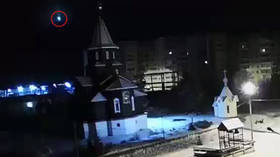‘Mars is alive’: NASA’s InSight lander REVEALS Red Planet is seismically active world

On the surface it looks like a cold, barren wasteland, but a fresh tranche of research based on data collected by NASA’s InSight mission has found that Mars is alive with seismic activity.
InSight is a robotic lander tasked with studying the deep interior of the Red Planet. It’s equipped with a range of scientific tools to probe Mars, including a seismometer for detecting quakes, sensors for gauging wind and air pressure, and a heat flow probe designed to take the planet's temperature.
Also on rt.com MARS RESISTS! NASA probe backs out of hole while burrowing into red planet’s surfaceStudies based on the craft’s first 10 months of observations were published on Monday, and they paint a picture of a planet that is routinely roiled by marsquakes, as well as dust devils and magnetic pulses.
“Mars is alive, and I’m getting more of the big picture every day,” the InSight mission tweeted after the studies were released.
Mars is alive, and I’m getting more of the big picture every day:✅ marsquakes!✅ whirlwinds!✅ mysterious magnetic pulses!Lots of new science, as my team releases findings from my experiments here on #Mars. Read all about it: https://t.co/bQ6uhIPusV
— NASA InSight (@NASAInSight) February 24, 2020
"We've finally, for the first time, established that Mars is a seismically active planet," InSight Principal Investigator Bruce Banerdt, of NASA's Jet Propulsion Laboratory (JPL), said.
"In fact, it's probably close to the kind of seismic activity you would expect to find away from the [tectonic] plate boundaries on Earth and away from highly deformed areas," he added.
The research indicates that Earth’s nearest neighbor trembles more often – and also more mildly – than expected. So far, the quakes seem to be much deeper than most tremors felt on Earth, coming at a depth of around 50 kilometers (31 miles). The largest had a magnitude of around 4.0.
Also on rt.com What a butte! Curiosity beams back hauntingly beautiful PHOTOS of barren Martian wastelandThe seismic data, acquired over 235 Martian days, revealed a total of 174 seismic events. "What is so spectacular about this data is that it gives us this beautifully poetic picture of what a day is actually like on another planet," explained Vedran Lekic, a geologist on the InSight team.
The mission is set to continue collecting data from the Red Planet throughout 2020.
Like this story? Share it with a friend!













